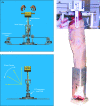The effect of tibiofemoral loading on proximal tibiofibular joint motion
- PMID: 17764523
- PMCID: PMC2375777
- DOI: 10.1111/j.1469-7580.2007.00803.x
The effect of tibiofemoral loading on proximal tibiofibular joint motion
Abstract
The human proximal tibiofibular joint (PTFJ) and its relationship to overall knee joint mechanics have been largely unexplored. This study describes force/displacement data from experiments done on four human cadaveric knee specimens and general conclusions obtained with the help of a statistical modeling technique. Specimens were rigidly affixed at the tibia to a force plate and the femur was attached to a custom made device allowing for manual load application. Motion of the fibular head was tracked relative to the tibial plateau by means of reflective markers and a high speed digital camera synchronized with the force plate data stream. Each specimen was subjected to a range of loading conditions and a quadratic regression model was created and then used to predict the specimen's response to standardized loading conditions and compare these across specimens. Statistical analysis was performed with a three-factor analysis of variance with repeated measures. Proximal tibiofibular joint motion was largest in the anterior-posterior direction with translations of 1-3 mm observed during a range of physiological loading conditions. The applied internal-external rotation moment had a significant effect on proximal tibiofibular joint translation (P < 0.05). Effects of varus-valgus loading and flexion angle were seen in some specimens. This study demonstrates that substantial proximal tibiofibular joint motion can occur in physiologic loading states. Preservation of proximal tibiofibular joint function, and anatomical variations which affect this function, may need to be considered when designing surgical procedures for the knee joint.
Figures



Similar articles
-
Kinematics of the proximal tibiofibular joint is influenced by ligament integrity, knee and ankle mobility: an exploratory cadaver study.Knee Surg Sports Traumatol Arthrosc. 2019 Feb;27(2):405-411. doi: 10.1007/s00167-018-5070-8. Epub 2018 Jul 28. Knee Surg Sports Traumatol Arthrosc. 2019. PMID: 30056605
-
Repair with bicortical suspension device restores proximal tibiofibular joint motion.Knee Surg Sports Traumatol Arthrosc. 2019 Feb;27(2):412-418. doi: 10.1007/s00167-018-5061-9. Epub 2018 Jul 23. Knee Surg Sports Traumatol Arthrosc. 2019. PMID: 30039295
-
The effect of distraction-resisting forces on the tibia during distraction osteogenesis.J Bone Joint Surg Am. 2009 Jul;91(7):1671-82. doi: 10.2106/JBJS.G.01238. J Bone Joint Surg Am. 2009. PMID: 19571090
-
Radiographical definition of the proximal tibiofibular joint - A cross-sectional study of 2984 knees and literature review.Injury. 2016 Jun;47(6):1276-81. doi: 10.1016/j.injury.2016.01.035. Epub 2016 Mar 3. Injury. 2016. PMID: 26975794 Review.
-
Proximal tibiofibular subluxation relationship to lateral knee pain: a review of proximal tibiofibular joint pathologies.J Orthop Sports Phys Ther. 1995 May;21(5):248-57. doi: 10.2519/jospt.1995.21.5.248. J Orthop Sports Phys Ther. 1995. PMID: 7787848 Review.
Cited by
-
An intact fibula may contribute to allow early weight bearing in surgically treated tibial plateau fractures.Knee Surg Sports Traumatol Arthrosc. 2018 Mar;26(3):756-761. doi: 10.1007/s00167-017-4428-7. Epub 2017 Mar 3. Knee Surg Sports Traumatol Arthrosc. 2018. PMID: 28255659
-
Proximal Tibiofibular Joint Arthritis Co-existing With a Medial Meniscal Tear: A Case Report.Cureus. 2022 Jun 11;14(6):e25849. doi: 10.7759/cureus.25849. eCollection 2022 Jun. Cureus. 2022. PMID: 35832756 Free PMC article.
-
A new distal fibular fragment of Homo floresiensis and the first quantitative comparative analysis of proximal and distal fibular morphology in this species.J Anat. 2025 Jun;246(6):869-891. doi: 10.1111/joa.14194. Epub 2025 Feb 18. J Anat. 2025. PMID: 39966695 Free PMC article.
-
The relationship between bipedalism and growth: A metric assessment in a documented modern skeletal collection (Certosa Collection, Bologna, Italy).Am J Biol Anthropol. 2022 Apr;177(4):669-689. doi: 10.1002/ajpa.24440. Epub 2021 Nov 16. Am J Biol Anthropol. 2022. PMID: 36787708 Free PMC article.
-
Mechanism and influencing factors of proximal fibular osteotomy for treatment of medial compartment knee osteoarthritis: A prospective study.J Int Med Res. 2018 Aug;46(8):3114-3123. doi: 10.1177/0300060518772715. Epub 2018 May 30. J Int Med Res. 2018. PMID: 29848141 Free PMC article.
References
-
- Andersen K. Dislocation of the superior tibiofibular joint. Injury. 1985;16:494–498. - PubMed
-
- Bellchamber TL, van den Bogert AJ. Contributions of proximal and distal moments to axial tibial rotation during walking and running. J Biomech. 2000;33(11):1397–1403. - PubMed
-
- Blankevoort L, Huiskes R, de Lange A. The envelope of passive knee joint motion. J Biomech. 1988;21(9):705–720. - PubMed
-
- Bozkurt M, Yilmaz E, Atlihan D, Tekdemir I, Havitcioglu H, Gunal I. The proximal tibiofibular joint: an anatomic study. Clin Orthop Relat Res. 2003;406:136–140. - PubMed
-
- de Seze MP, Rezzouk J, de Seze M. Anterior innervation of the proximal tibiofibular joint. Surg Radiol Anat. 2005;27(1):30–32. - PubMed
Publication types
MeSH terms
Grants and funding
LinkOut - more resources
Full Text Sources

